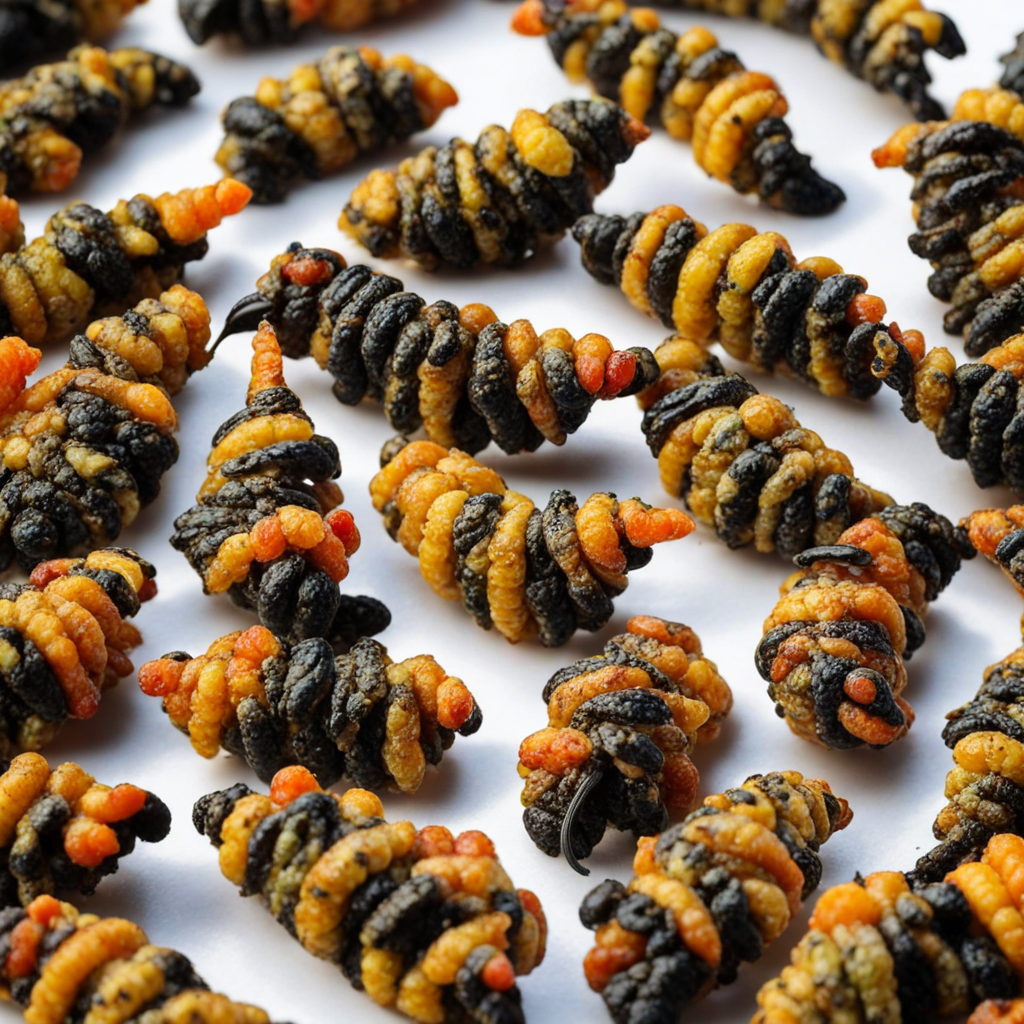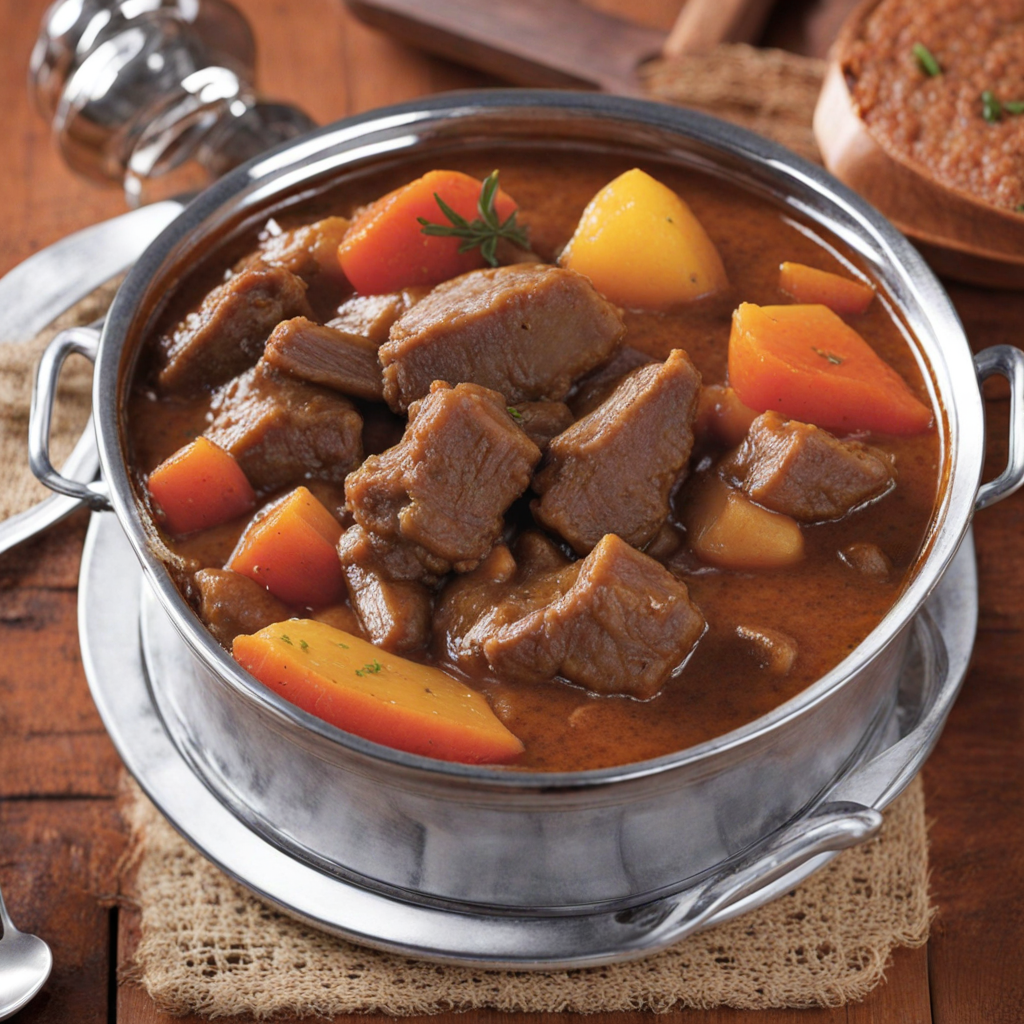Mopane Worms
Mopane worms, known locally as “mopane caterpillars,” are the edible larvae of the Emperor Moth, found in the mopane tree forests of Southern Africa, particularly in South Africa. These protein-packed delicacies are typically harvested during the rainy season when they are plump and rich in flavor. The worms are traditionally sun-dried or smoked to enhance their taste and preserve them for later use. When cooked, they take on a chewy texture, reminiscent of jerky, with a unique umami flavor that often surprises first-time tasters. The preparation of mopane worms varies widely across different cultures in South Africa. They can be enjoyed in a variety of dishes, from stews and soups to being simply fried with onions and spices. Many local recipes incorporate them into traditional meals, often paired with staple ingredients like maize porridge or served as a protein-rich snack. The cooking process enhances their nutty, earthy flavor, making them a beloved ingredient among those who appreciate bold and adventurous tastes. Mopane worms are not only a culinary delight but also a sustainable food source, rich in protein, fiber, and essential nutrients. Their consumption supports local economies and encourages the use of indigenous ingredients. For those eager to explore new flavors, mopane worms offer an exciting opportunity to experience the rich culinary heritage of South Africa while also embracing a food source that has been cherished for generations.
How It Became This Dish
The History of Mopane Worms: A Culinary Tradition from Southern Africa #### Origins Mopane worms, known scientifically as *Gonimbrasia belti*, are the larvae of the Emperor Moth, native to the mopane tree (*Colophospermum mopane*), which thrives in the semi-arid regions of southern Africa, particularly in countries like Botswana, Zimbabwe, Namibia, and South Africa. The harvesting of these worms has been a part of local culinary traditions for centuries, with origins deeply rooted in indigenous cultures that have relied on the rich biodiversity of the region for sustenance. The mopane tree itself is a vital part of the ecosystem, providing food and habitat for numerous species, including the mopane worm. The life cycle of the Emperor Moth involves the larvae feeding on the leaves of the mopane tree during the rainy season, typically from December to April, before pupating and emerging as moths. This natural cycle makes mopane worms a seasonal delicacy, celebrated for their nutritional value and unique flavor. #### Cultural Significance Mopane worms hold significant cultural importance among various ethnic groups in southern Africa, particularly the Tswana, Shona, and various communities in Namibia and Botswana. For these communities, mopane worms are not just a food source; they represent a connection to the land and a way of life that has been passed down through generations. Traditionally, mopane worms are harvested by hand, and this practice fosters community engagement and cooperation. The harvesting process itself is often a communal event, where families and neighbors come together to gather the worms. This social aspect strengthens community bonds and reinforces cultural identity. After the harvest, the worms are typically sun-dried or smoked to preserve them, creating a product that can be stored and consumed throughout the year. In many regions, mopane worms are not only a staple food but also an important source of income. They are often sold in local markets, providing livelihoods for many families. As the demand for mopane worms has grown, particularly among urban populations and in international markets, the role of these worms in the economy has expanded, showcasing their significance beyond mere sustenance. #### Nutritional Value Mopane worms are renowned for their high nutritional content. They are rich in protein, vitamins, and minerals, making them a valuable food source, especially in rural areas where access to diverse diets may be limited. A serving of mopane worms can contain up to 60% protein, alongside essential fatty acids and significant amounts of calcium, iron, and other micronutrients. This nutritional profile has made mopane worms increasingly popular in discussions around food security and sustainable nutrition, especially as communities face challenges related to climate change and food scarcity. The ability of mopane worms to thrive on the mopane tree, which is well-adapted to arid conditions, presents an opportunity for sustainable food production that requires minimal agricultural inputs. #### Development Over Time As societies have evolved, so too has the consumption and perception of mopane worms. Traditionally, they were seen mainly as a food for local communities. However, with the globalization of food markets and increasing interest in indigenous and traditional foods, mopane worms have gained recognition beyond their regional roots. In the early 2000s, the growing trend of entomophagy—the practice of eating insects—sparked a renewed interest in mopane worms, both within southern Africa and internationally. Researchers and food advocates began to promote them as a sustainable protein source, emphasizing their low environmental impact compared to conventional livestock farming. This advocacy coincided with a broader movement focused on sustainable agriculture and the need for food systems that can withstand the pressures of a changing climate. As a result, mopane worms have started to appear on the menus of gourmet restaurants, both within Africa and abroad, where they are often prepared in creative ways that highlight their unique flavor and texture. Chefs have experimented with mopane worms in dishes ranging from traditional stews to modern fusion cuisine, showcasing their versatility and introducing them to new audiences. However, this increased interest also raises questions about sustainability and the impact of commercial harvesting on local ecosystems. The delicate balance between traditional harvesting practices and commercial exploitation is a critical issue that communities and policymakers must navigate. Efforts are underway to promote sustainable harvesting practices and ensure that local communities benefit economically while preserving their cultural heritage. #### Modern Culinary Applications In contemporary cuisine, mopane worms are typically prepared in a variety of ways. They can be cooked in stews, fried, or incorporated into savory dishes. In some cultures, they are often served with traditional staples, such as porridge or maize meal, enhancing the nutritional value of these simple dishes. The flavors of mopane worms are often described as rich and nutty, with a chewy texture that lends itself well to various cooking methods. In addition to traditional recipes, modern chefs have begun to incorporate mopane worms into innovative dishes, such as salads, tacos, and even pizza toppings. This fusion of traditional and contemporary culinary practices reflects a growing appreciation for indigenous ingredients and the stories they carry. #### Conclusion Mopane worms are more than just a food item; they embody the rich tapestry of southern African culture, history, and ecology. From their origins as a seasonal delicacy to their contemporary status as a sustainable food source, mopane worms reflect the resilience and adaptability of communities in the face of changing circumstances. As the global food landscape continues to evolve, the story of mopane worms serves as a reminder of the importance of preserving traditional food practices while embracing innovation and sustainability. The future of mopane worms, as both a culinary delight and a symbol of cultural heritage, remains bright, promising to nourish both bodies and communities for generations to come.
You may like
Discover local flavors from South Africa







